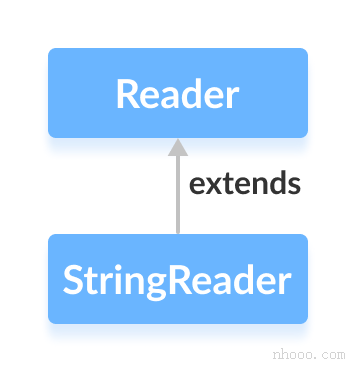编辑这个页面须要登录或更高权限!
- 您刚才的请求只有这个用户组的用户才能使用:自动确认用户
- 如果您还没有登录请登录后重试。编程那点事是一个开放式网站,修改本站大部分内容仅须要花10秒钟时间创建一个账户。 如果您已经登录,本页面可能是受保护的内容。如果您认为有修改的必要,请联系本站管理人员。
- 该页面已被锁定以防止编辑。
Java StringReader 类
在本教程中,我们将借助示例学习Java StringReader及其方法。
java.io包的StringReader类可用于从字符串读取数据(以字符为单位)。
它继承了抽象类Reader。

注意:在StringReader中,指定的字符串充当源,从其中分别读取字符。
创建一个StringReader
为了创建一个StringReader,我们必须首先导入java.io.StringReader包。导入包后,就可以创建字符串读取器了。
//创建 StringReader StringReader input = new StringReader(String data);
在这里,我们创建了一个StringReader,它从指定的名为data的字符串中读取字符。
StringReader的方法
StringReader类为Reader类中的不同方法提供了实现。
read()方法
read() - 从字符串读取器读取单个字符
read(char[] array) - 从阅读器读取字符并将其存储在指定的数组中
read(char[] array, int start, int length) - 从阅读器读取等于length字符的数量,并从start位置开始存储在指定的数组中
示例:Java StringReader
import java.io.StringReader;
public class Main {
public static void main(String[] args) {
String data = "This is the text read from StringReader.";
//创建一个字符数组
char[] array = new char[100];
try {
//创建一个StringReader
StringReader input = new StringReader(data);
//使用read方法
input.read(array);
System.out.println("从字符串读取数据:");
System.out.println(array);
input.close();
}
catch(Exception e) {
e.getStackTrace();
}
}
}输出结果
从字符串读取数据: This is the text read from StringReader.
在上面的示例中,我们创建了一个名为input的字符串读取器。 字符串阅读器链接到字符串数据(data)。
String data = "This is a text in the string."; StringReader input = new StringReader(data);
为了从字符串中读取数据,我们使用了read()方法。
在此,该方法从阅读器读取字符数组,并将其存储在指定的数组中。
skip()方法
要丢弃和跳过指定数量的字符,可以使用skip()方法。例如
import java.io.StringReader;
public class Main {
public static void main(String[] args) {
String data = "This is the text read from StringReader";
System.out.println("原始数据: " + data);
//创建一个字符数组
char[] array = new char[100];
try {
//创建 StringReader
StringReader input = new StringReader(data);
//使用 skip() 方法
input.skip(5);
//使用 read 方法
input.read(array);
System.out.println("跳过5个字符后的数据:");
System.out.println(array);
input.close();
}
catch(Exception e) {
e.getStackTrace();
}
}
}输出结果
原始数据: This is the text read from the StringReader 跳过5个字符后的数据: is the text read from the StringReader
在上面的示例中,我们使用skip()方法从字符串读取器中跳过5个字符。因此,字符'T'、'h'、'i'、's'和' '从原始字符串读取器中被跳过。
close()方法
要关闭字符串阅读器,我们可以使用该close()方法。调用close()方法后,我们将无法使用读取器从字符串读取数据。
StringReader的其他方法
| 方法 | 描述 |
|---|---|
| ready() | 检查字符串读取器是否准备好被读取 |
| mark() | 标记读取器中已读取数据的位置 |
| reset() | 重置标记,返回到阅读器中设置标记的位置 |
- Copyright © 2003-2013 菜鸟教程。
- 版权与免责声明
